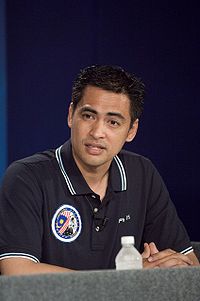
Science and technology in Malaysia
Encyclopedia

Ministry of Science, Technology and Innovation (Malaysia)
The Ministry of Science, Technology and Innovation or MOSTI is the Malaysian ministry in charge of research, telecommunication and information technology. The current minister is Datuk Dr...
. Other ministries, such as the Ministry of Agriculture and the Ministry of Health also have science departments. Training in scientific areas was promoted during the 1970s and 1980s. From 1987-1997 research and development used 0.24% of GNP, and in 1998 high-tech exports made up 54% of Malaysia's manufactured exports.
In 2002 the Malaysian National Space Agency (Angkasa) was formed to deal with all of Malaysia's activities in space, and to promote space education and space experiments. It is focused on developing the "RazakSAT" satellite, which is a remote sensing satellite with CCD cameras. In early 2006, Sheikh Muszaphar Shukor
Sheikh Muszaphar Shukor
Sheikh Muszaphar Shukor is a Malaysian orthopaedic surgeon and was the first Malaysian to go into space. He was launched to the International Space Station aboard Soyuz TMA-11 with the Expedition 16 crew on October 10, 2007...
and three other finalists were selected for the Angkasawan spaceflight programme. This programme came about when Russia agreed to transport one Malaysian to the International Space Station
International Space Station
The International Space Station is a habitable, artificial satellite in low Earth orbit. The ISS follows the Salyut, Almaz, Cosmos, Skylab, and Mir space stations, as the 11th space station launched, not including the Genesis I and II prototypes...
as part of a multi-billion dollar purchase of 18 Russian Sukhoi Su-30MKM fighter jets by the Royal Malaysian Air Force.
In an effort to create a self-reliant defensive ability and support national development Malaysia privatized some of its military facilities in the 1970s. This has created a defence industry, which in 1999 was brought under the Malaysia Defence Industry Council
Malaysia Defence Industry Council
The Malaysia Defence Industry Council , formed in 1999, is tasked with coordinating the orderly development of the Malaysia Defence Industry Sector. It is chaired by the Malaysian Minister of Defence, and involves 56 members from the private sector as well as from the Government...
. The government continues to try and promote this sector and its competitiveness, actively marketing the defence industry. One way it does this is through the Langkawi International Maritime and Aerospace Exhibition, one of the largest defence and civil showcases in the Asia Pacific, regularly attended by over 500 companies. The Malaysian Armed Forces relies heavily on local military technology and high-tech weapons systems designed and manufactured by foreign countries.
The Malaysian Antarctic Research Programmer (MARP) began in 1997 following an invitation from New Zealand to use Scott Base
Scott Base
Scott Base is a research facility located in Antarctica and is operated by New Zealand. It was named after Captain Robert Falcon Scott, Royal Navy, leader of two British expeditions to the Ross Sea area of Antarctica...
and Malaysian cabinet approval. A taskforce created by the Academy of Sciences Malaysia sent their first expedition in 1999. On 5 August 2002 the University of Malaya established the National Antarctic Research Centre. MARP's area of interest was extended to the arctic in 2006. On 31 October 2011 Malaysia became a party to the Antarctic Treaty.

